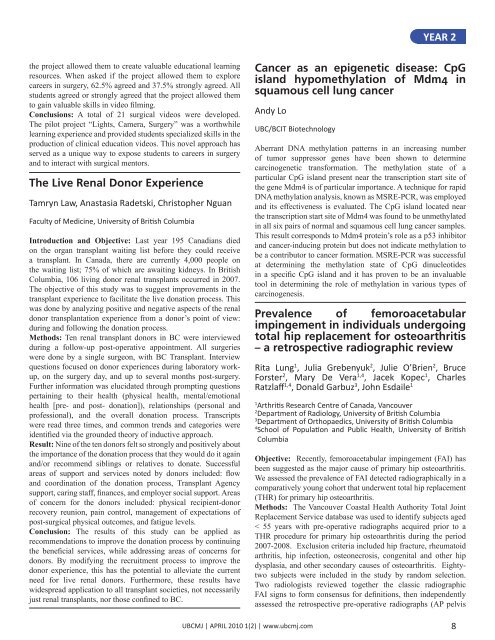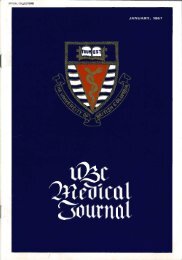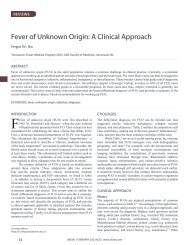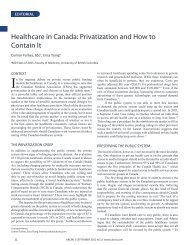Download full PDF - UBC Medical Journal
Download full PDF - UBC Medical Journal
Download full PDF - UBC Medical Journal
Create successful ePaper yourself
Turn your PDF publications into a flip-book with our unique Google optimized e-Paper software.
YEAR 2<br />
the project allowed them to create valuable educational learning<br />
resources. When asked if the project allowed them to explore<br />
careers in surgery, 62.5% agreed and 37.5% strongly agreed. All<br />
students agreed or strongly agreed that the project allowed them<br />
to gain valuable skills in video filming.<br />
Conclusions: A total of 21 surgical videos were developed.<br />
The pilot project “Lights, Camera, Surgery” was a worthwhile<br />
learning experience and provided students specialized skills in the<br />
production of clinical education videos. This novel approach has<br />
served as a unique way to expose students to careers in surgery<br />
and to interact with surgical mentors.<br />
The Live Renal Donor Experience<br />
Tamryn Law, Anastasia Radetski, Christopher Nguan<br />
Faculty of Medicine, University of British Columbia<br />
Introduction and Objective: Last year 195 Canadians died<br />
on the organ transplant waiting list before they could receive<br />
a transplant. In Canada, there are currently 4,000 people on<br />
the waiting list; 75% of which are awaiting kidneys. In British<br />
Columbia, 106 living donor renal transplants occurred in 2007.<br />
The objective of this study was to suggest improvements in the<br />
transplant experience to facilitate the live donation process. This<br />
was done by analyzing positive and negative aspects of the renal<br />
donor transplantation experience from a donor’s point of view:<br />
during and following the donation process.<br />
Methods: Ten renal transplant donors in BC were interviewed<br />
during a follow-up post-operative appointment. All surgeries<br />
were done by a single surgeon, with BC Transplant. Interview<br />
questions focused on donor experiences during laboratory workup,<br />
on the surgery day, and up to several months post-surgery.<br />
Further information was elucidated through prompting questions<br />
pertaining to their health (physical health, mental/emotional<br />
health [pre- and post- donation]), relationships (personal and<br />
professional), and the overall donation process. Transcripts<br />
were read three times, and common trends and categories were<br />
identified via the grounded theory of inductive approach.<br />
Result: Nine of the ten donors felt so strongly and positively about<br />
the importance of the donation process that they would do it again<br />
and/or recommend siblings or relatives to donate. Successful<br />
areas of support and services noted by donors included: flow<br />
and coordination of the donation process, Transplant Agency<br />
support, caring staff, finances, and employer social support. Areas<br />
of concern for the donors included: physical recipient-donor<br />
recovery reunion, pain control, management of expectations of<br />
post-surgical physical outcomes, and fatigue levels.<br />
Conclusion: The results of this study can be applied as<br />
recommendations to improve the donation process by continuing<br />
the beneficial services, while addressing areas of concerns for<br />
donors. By modifying the recruitment process to improve the<br />
donor experience, this has the potential to alleviate the current<br />
need for live renal donors. Furthermore, these results have<br />
widespread application to all transplant societies, not necessarily<br />
just renal transplants, nor those confined to BC.<br />
Cancer as an epigenetic disease: CpG<br />
island hypomethylation of Mdm4 in<br />
squamous cell lung cancer<br />
Andy Lo<br />
<strong>UBC</strong>/BCIT Biotechnology<br />
Aberrant DNA methylation patterns in an increasing number<br />
of tumor suppressor genes have been shown to determine<br />
carcinogenetic transformation. The methylation state of a<br />
particular CpG island present near the transcription start site of<br />
the gene Mdm4 is of particular importance. A technique for rapid<br />
DNA methylation analysis, known as MSRE-PCR, was employed<br />
and its effectiveness is evaluated. The CpG island located near<br />
the transcription start site of Mdm4 was found to be unmethylated<br />
in all six pairs of normal and squamous cell lung cancer samples.<br />
This result corresponds to Mdm4 protein’s role as a p53 inhibitor<br />
and cancer-inducing protein but does not indicate methylation to<br />
be a contributor to cancer formation. MSRE-PCR was successful<br />
at determining the methylation state of CpG dinucleotides<br />
in a specific CpG island and it has proven to be an invaluable<br />
tool in determining the role of methylation in various types of<br />
carcinogenesis.<br />
Prevalence of femoroacetabular<br />
impingement in individuals undergoing<br />
total hip replacement for osteoarthritis<br />
– a retrospective radiographic review<br />
Rita Lung 1 , Julia Grebenyuk 2 , Julie O’Brien 2 , Bruce<br />
Forster 2 , Mary De Vera 1,4 , Jacek Kopec 1 , Charles<br />
Ratzlaff 1,4 , Donald Garbuz 3 , John Esdaile 1<br />
1<br />
Arthritis Research Centre of Canada, Vancouver<br />
2<br />
Department of Radiology, University of British Columbia<br />
3<br />
Department of Orthopaedics, University of British Columbia<br />
4<br />
School of Population and Public Health, University of British<br />
Columbia<br />
Objective: Recently, femoroacetabular impingement (FAI) has<br />
been suggested as the major cause of primary hip osteoarthritis.<br />
We assessed the prevalence of FAI detected radiographically in a<br />
comparatively young cohort that underwent total hip replacement<br />
(THR) for primary hip osteoarthritis.<br />
Methods: The Vancouver Coastal Health Authority Total Joint<br />
Replacement Service database was used to identify subjects aged<br />
< 55 years with pre-operative radiographs acquired prior to a<br />
THR procedure for primary hip osteoarthritis during the period<br />
2007-2008. Exclusion criteria included hip fracture, rheumatoid<br />
arthritis, hip infection, osteonecrosis, congenital and other hip<br />
dysplasia, and other secondary causes of osteoarthritis. Eightytwo<br />
subjects were included in the study by random selection.<br />
Two radiologists reviewed together the classic radiographic<br />
FAI signs to form consensus for definitions, then independently<br />
assessed the retrospective pre-operative radiographs (AP pelvis<br />
<strong>UBC</strong>MJ | APRIL 2010 1(2) | www.ubcmj.com 8










